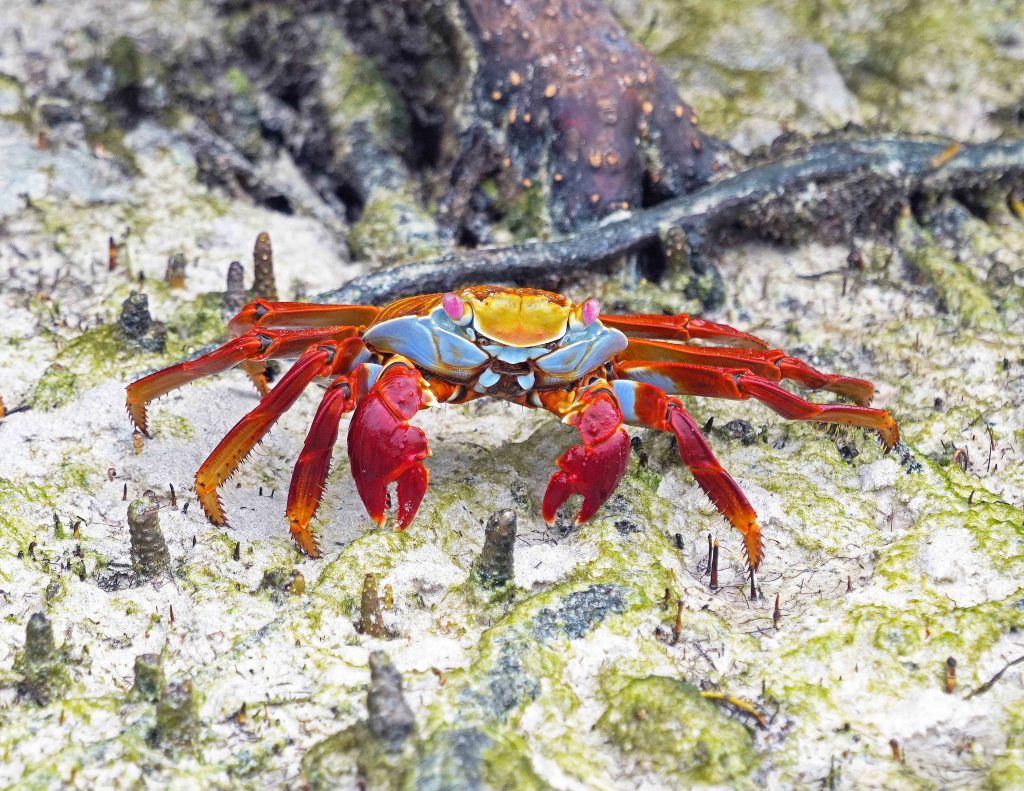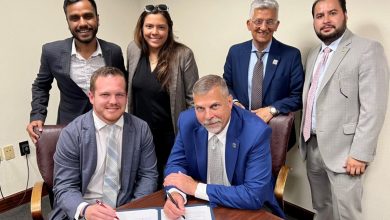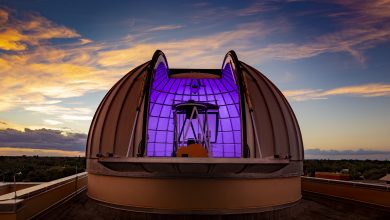Far Away, Where the Learning is Everywhere
Summer field research course immerses students in the sights, sounds and science of the Galápagos.
Photos by Rich Aronson
It wasn’t the usual classroom or the usual classmates.
Madison Zerona, a marine biology senior at Florida Tech, was snorkeling at Kicker Rock off San Cristóbal Island in the Galápagos archipelago this summer, joined by scalloped hammerhead sharks, Galápagos sharks and large sea turtles.
“It still gives me shivers,” she says, weeks after the thrilling experience. “It’s amazing how animals in the Galápagos do not see humans as threats and are all very calm around us.”

It is pretty amazing, as well, to see lessons studied on Florida Tech’s Melbourne campus brought to life in one of the most significant scientific environments in the world.
“Traveling with a group of enthusiastic scientists and two experienced guides through what feels like another planet, you really get to learn a lot in such a short time span,” Zerona says. “I was able to take what I learned in the classroom and apply it in the field by collecting data and learning how to analyze it quickly. The information really clicks in your head when you are able to witness it in real life.”
The class is Field Biology and Evolution of the Galápagos Islands, one of several summer field research courses offered at Florida Tech.
“I think this type of experiential learning is very beneficial. It gets people out of the classroom and actually experiencing the world and the environment,” says fellow traveler and marine biology student Joshua Ahrens. “Biology field courses especially work well because it’s hard to learn about the ecology side of biology without some form of visualization, and what’s better visualization than being in the ecosystem itself? It really helps complete the whole learning experience.”

Richard Aronson, a marine biologist, professor and department head in ocean engineering and marine sciences, led the 2023 Galápagos expedition. Working with his colleague and friend Professor Mark Bush, Aronson has taught or co-taught nearly a dozen trips to both the Galápagos and the Amazon, courses that Bush launched in the early aughts. (Bush was unable to attend this trip due to an ankle injury from an earlier field expedition.)
Involving 20 students and days of travel by car, plane, boat and foot, the trips currently cost about $4,700 per student for everything, including all travel expenses and three college credits for the class. Accommodations in the Galápagos are generally modest hotels, and internet service is spotty. No one complains.
“I signed up for this trip because it was a once-in-a-lifetime opportunity to travel to the Galápagos Islands, a place you’ve been learning about since elementary school,” Zerona says. “The price is well worth the credits, and it’s a jam-packed trip that you didn’t have to do any of the planning for, with meals included.”
Aronson remembers that his own family used its modest surplus income to travel, teaching him its value and the power of firsthand experiences.
“When you travel, you learn,” he says. You learn, but you learn amid what he called “intangibles and collaterals” encountered only on these journeys: the scents and sounds, the emotions.
“You see something that you’ve never seen before. Not only have you not seen it before, but it’s incredibly dramatic, and you think, ‘Oh my God, I’m looking at a waved albatross sitting on its egg. I never thought I’d see that,’” Aronson says. “It does something to your mind, and in a good way.”

The sensation of seeing a unique animal in real life plays out many times on the field research trips, given the diversity of the Galápagos Islands. Giant tortoises, lava lizards, swallow-tailed gulls, Darwin’s finches, Galápagos penguins, blue-footed boobies, pintail ducks—those are just some of the terrestrial critters. Others, such as sharks and sea turtles, as well as sea lions and large, colorful fish, are on view for snorkelers and divers. Upwelling of nutrient-rich waters feeds the plankton that support all the fabulous sea creatures, as well as the large population of seabirds.
“There were absolutely stunning views both under and above the water, as well as some of the most beautiful animals I’ve ever seen,” Ahrens says. “The amazing thing, as well, is that all of those animals were truly wild. Seeing that much biodiversity in such a relatively undisturbed habitat was an incredible experience. My expectations were high, and they might’ve even been exceeded.”

As part of the class, students conduct surveys of marine life to test hypotheses, such as whether having larger populations of sea urchins and parrotfish means there is less seaweed around.
“Simple stuff, but important,” Aronson says.
They then write papers about their analyses.
Students also must keep a journal, essentially a naturalist’s log. It features thoughts about what they are seeing but also about their feelings and experiences.
They also must be prepared for some serious walking. Among the most challenging is a rough, 10-mile hike along the rim of the Sierra Negra volcano on Isabela Island. The first part is straight uphill, Aronson says—“a total kick in the shorts.” After they view the volcano’s caldera, a large volcanic crater, the walk takes the group through the rough terrain of a scenic lava field called Volcan Chico, a “parasitic cone” on the flank of the Sierra Negra.
“This is not a vacation,” Aronson says. “We push hard, both physically and mentally.”
He adds, “Everywhere you look is science; everything you see is a lesson come to life. In the rain, drifting with the ocean currents, on 10-mile hikes—and no one would change a thing.”


This piece was featured in the fall 2023 edition of Florida Tech Magazine.






